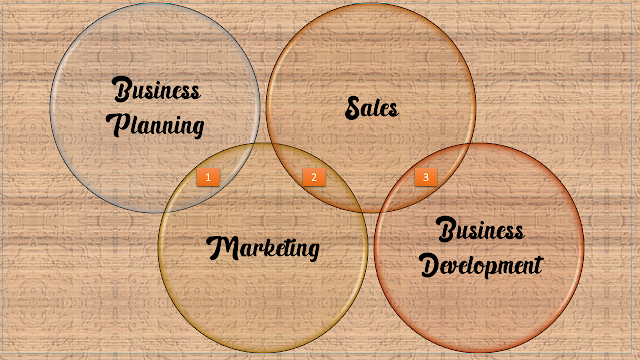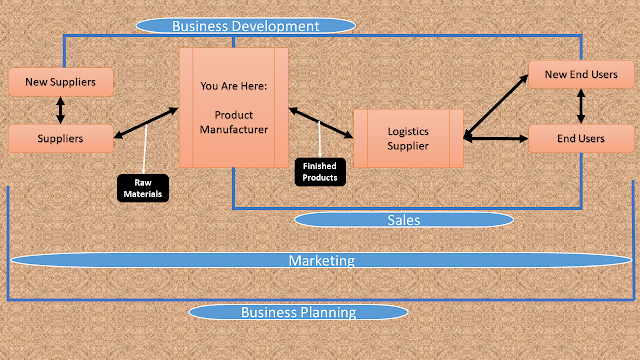Difference Between Business Development, Sales, Marketing, and Business Planning
Very often, people confuse the business functions or titles of business development, sales and marketing, with business planning, and that creates a lot of mis-interpretation in the job descriptions of HR team, with the job applicants and/or the employee himself.
During my 15 years of humble experience, I have seen and analyzed a lot of organizations where these functions are not handled properly and mixed in many wrong ways, so I decided to clarify few definitions from practical point of view and I'm open to hear and see your comments regarding my views.
Of course, this article is based on the latest market progresses and statistics about the functions, not about the old functional ways because there is a big difference between the past and present.
Marketing have progressed tremendously, and business planning is becoming a major role of entrepreneur's life.
Definition and Integration
 |
| Functional Integration with Links |
Business Planning
Let's start with the business planning as this role might be the most important role for entrepreneurs to found their business, to fund their business, and to plan for partnerships, mergers and acquisitions.
Business planning, as defined in my previous article, Entrepreneurship Definition, is composed of four main functions: Operation/technical, Marketing, Finance, and Corporate Social Responsibility.
This role sets the path to all other roles of this article and it is created from the organization's establishment date and updated regularly.
Business Planning contains the organization's vision, mission, strategy, market analysis, competitor analysis, marketing strategy, financial analysis and projections, risk analysis and social responsibility.
Each business developer, sales man and marketing strategist should read and memorize this article in order to perform well in his function, either a new hired or existing employee.
The company board and top management are responsible of updating business planning's definition for each minor or major change initiative. major parts of this role's definition should be printed and stuck on the walls or pinboards of employees so that they can refer to it often.
Many organizations pay thousands of dollars to gather their employees worldwide for internal events to announce their new strategies. Those strategies are the core part of business planning.
Marketing
As explained above, marketing is one of the four pillars of business planning, and without it, the strategy will not be defined correctly.
Marketing will let the employees know their guidelines and where they should operate, how they should operate and who are their competitors.
Marketing strategy studies the market by segments, by targets, and by brand position. You can easily define where do you stand and put your efforts as a sales or business development, so you don't waste your time on clients that were not and will not be your clients.
Also, marketing defines the product/service price through the marketing mix strategy. Earlier, marketing mix consisted of 4Ps (product, price, promotion, and place), but now marketing mix consists of 8Ps (4Ps, people, processes, programs, and performance).
Nowadays, marketing people became proactive rather than corrective players. They study the consumer behavior, they launch products and test samples on a group of clients and take their reactions to rationalize their results and complete their researches.
Branding your products/services became also a separate critical section of the marketing strategy for organizations, who want to take the major market share and thus, they want to know where do they stand from their customer base, how clients think and categorize their products and services.
Marketing people are the bees of each organizations, they put one main and major target in front of their eyes and don't stop unless they reach it: Customer is king. Customer is always right. Thus, all their strategies might include a lot of changes based on their market research affected by consumer changes in behavior.
Today, with the era of digital, marketing became crucial. All the organization's staff participate in setting the marketing strategy in order to come out with the best outcomes to satisfy the customers.
Marketing plans constitute the inputs of most of the organization's departments: public relations, sales and business development, supply chain, finance, and corporate social responsibility.
Sales
All humans are salespersons. We are born to sell.
As a single proposing to your future wife: you sell your mind and appearance to her.
As a negotiator, you sell your your thoughts using your convincing skills.
As an entrepreneur: you sell your ideas to investors, to your employees, to your clients.
As a sales employee: you sell your products and services to potential clients.
The sales process is embedded in our personalities. It is built-in, so that we can nurture it or leave it to hibernate: Hibernation not death because we can awaken it any time with passion and willingness.
In order to succeed in sales, all your inputs should rely on the market study which should be completed before you go out for selling. As a salesperson, you build your sales pipeline by searching "your market" for potential clients and arrange calls and meetings with them to generate orders.
This process is done several times and involves sometimes unethical acts of satisfying the clients to reach the targets.
Sales is always linked to quotas and targets. If you meet your target than your management will increase the target for you until you can't afford it and hate yourself, and most probably leave the company. Leaving the company could be because you attracted other companies with your achievements and they offer you a better package to join them.
Business Development
As its name says, you are developing a business, which means this business does not exist yet. Most organizations link this position to an act of cold calling sales process until hooking the client, than handing him over to sales team and proceeding to another development.
Practically, this linkage is not precise enough, because business development people can open a business with clients and suppliers as indicated in the figure below.
Business development people take the market study from the marketing plan and start building a strong chain of alliances, partnerships, agencies, promoters, and clients from scratch. They open the doors for sales people to penetrate and invade the client's kingdom and generate orders. Sometimes they themselves, can generate orders from the first meeting or they can save a lot of money from suppliers also from the first meeting.
Integration
As a result, and from a higher level or view, we can easily differentiate between the classification of those roles from design and execution point of view, without under-valuing or underestimating any of them.
All of them are important and constitute the core functions of each organization, as each company is founded to sell, whether profit or non-profit:
Design Functions:
Business Planning
Marketing
Execution Functions:
Business Development
Sales
[1] - Integration between Business Planning and Marketing: Marketing is a function of business planning.
[2] - Integration between Marketing and Sales: Marketing plan feeds the sales team with input in order to act accordingly.
[3] - Integration between Sales and Business Development: Business Development is by itself a sales process but at its first stage of opening the door to the sales team. In addition.
Roles and Limitations
 |
| Functions Analysis From Supply Chain Perspective |
To simplify the drawing, I indicated in the figure above the four processes start and end, and their interactions.
As an entrepreneur, you are producing a product or a service, thus you need raw information/materials to transform it to finished products or services.
First and before establishing your organization, you start planning. You build you business plan which consists the main source of you whole interactions.
What's your vision, mission and strategy?
What information or materials are required to start your business? where to get them from and how much they cost?
How many employees should you hire and how much salaries will you provide them? What is your salary increase scale?
Which market you want to approach? How to segment it? What to target? How do you want position your brand?
What prices you want to offer? What promotion plans you can offer? What digital strategy you need to follow and how much it costs?
How much startup costs are involved and how they will increase for the next five to ten years? What will be your expected revenues and expenses? How do you plan your cash inflows and outflows? How to react to seasonality and how to mitigate the risks?
How to interact with your society and how much budget to dedicate for social responsibility?
Between the lines of the above questions, lies all the information required to build your present and future with a high percentage of precision.
If you, as an entrepreneur, share this information with your team, they will feel part of the company, no matter their positions, and they will feel responsible to achieve your vision and be part of it.
For any clarifications, please do not hesitate to drop me a message.
